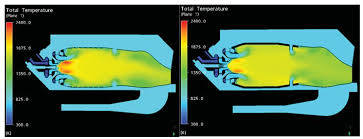PLASMA-ASSISTED COMBUSTION WITH KGMF

Plasma assisted combustion
The study of plasma-assisted combustion (PAC) and plasma-assisted ignition (PAI) is motivated by the goal of optimizing combustion characteristics for novel engine concepts. The generality of this statement lies with the different characteristics of interest for different applications, while developing a better understanding of the underlying chemistry applies to every scenario. For over a century, spark-ignition internal combustion engines have use thermal-equilibrium plasmas in the form of arc discharges; however, these discharges rely on localized gas heating to initiate and propagate combustion, and provide limited options for control of ignition process . Starting in the 20th century, the use of non-equilibrium plasma for ignition and combustion has received interest due to possibilities for modified ignition pathways, flame stabilization, and byproduct control. The seminal work of Haselfoot and Kirkby introduced the concept of electrical interaction with the combustion process, resulting in an explosion of work to study the physics involved and potential applications. More recently in the 1980s, the effect of non-equilibrium plasma discharges on combustion kinetics was demonstrated by the pioneering experimental works by Kimura et. al and Behbahani et. al with plasma jet applications to high speed propulsion and NOx destruction respectively. A plethora of experimental studies have demonstrated characteristics of different discharges with different gas mixtures in different regimes, however, even with a growing list of methods that can be shown to benefit the combustion process, it remains unclear which plasmas are optimal for specific applications. While the literature contains multiple review papers on PAC/PAI studies and applications, the largest gap in PAC/PAI theory that remains is an understanding of the intricacies of plasma-combustion chemistry. Numerical modeling presents an opportunity to dissect components of the PAC/PAI processes while neglecting or approximatingcomplexities which arise from completely coupled systems. This work provides an overview of PAC fundamentals in the context of volume-averaged global modeling followed by an analysis of the kinetic reaction chemistry effects resulting from nonequilibrium plasma discharges. Starting with an introduction to classical combustion theory, this chapter then continues into the general motivation and fundamentals of PAC/PAI. Nanosecond discharges are chosen for modeling following the progression of experimental works highlighting the focused study of non-equilibrium plasma chemistry in the ignition process. Numerical modeling results follow a description of the specifics of the global model formulation and systems used.
Classical Combustion
Prior to the end of the 18th century, the concept of combustion relied heavily on the legacy of Greek philosophers to whom fire was a classical element. Developed formally by Georg Ernest Stahl (following the works of Johann Joachim Becher) phlogiston theory attempted to explain oxidation as the release of a fire-like element through the process of dephlogistication . The lack of an explanation for reaction products having a larger mass than the original reactants, such as in the creation of metal oxides from heating metals in air, seeded doubt and eventually led to the theory’s abandonment. While supporters attempted to define a negative mass of phlogiston in their defense, the root of the problem was in not knowing the composition of the air. Starting with experiments in the 1770s attempting to explain the results of phlogiston-supporter Joseph Priestly, Antoine-Laurent Lavoisier determined that the composition of air contained a mixture of at least two gases: an inert gas and one on which combustion was reliant. The latter, found in most acids and supporting both respiration and combustion, he named “oxygène,” from the Greek words for acid generator. With his public attack on phlogiston theory beginning in 1783 based in a demand for strict involvement of the scientific method, Lavoisier presented the modern foundations of combustion in his book Traité élémentaire de Chemie . Though Lavoisier proposed empirical arguments, the development of a kinetic theory of gases, by James Clerk Maxwelland Ludwig Boltzmann in the 19th century, led to an explanation of the heat and energy involved in combustion. Combustion is an exothermic chemical reaction incorporating both a fuel and oxidizer, complicated by a dependence on both mechanical and chemical processes. While a complete picture of the combustion process requires mechanical processes , such as mass and heat transfer, the scope of this work aims to develop an understanding of the chemical processes and demonstrate how plasmas might provide augmentation of combustion characteristics. In the context of volume-averaged modeling, these mechanical processes are handled with approximations (e.g. loss of particle density due to gas flow) as opposed to having fully-resolved dynamics (e.g. turbulent mixing of fuel and oxidizer). With the implementation of mechanical approximations discussed later, this section will provide a brief introduction to chain branching and explosion limits.


